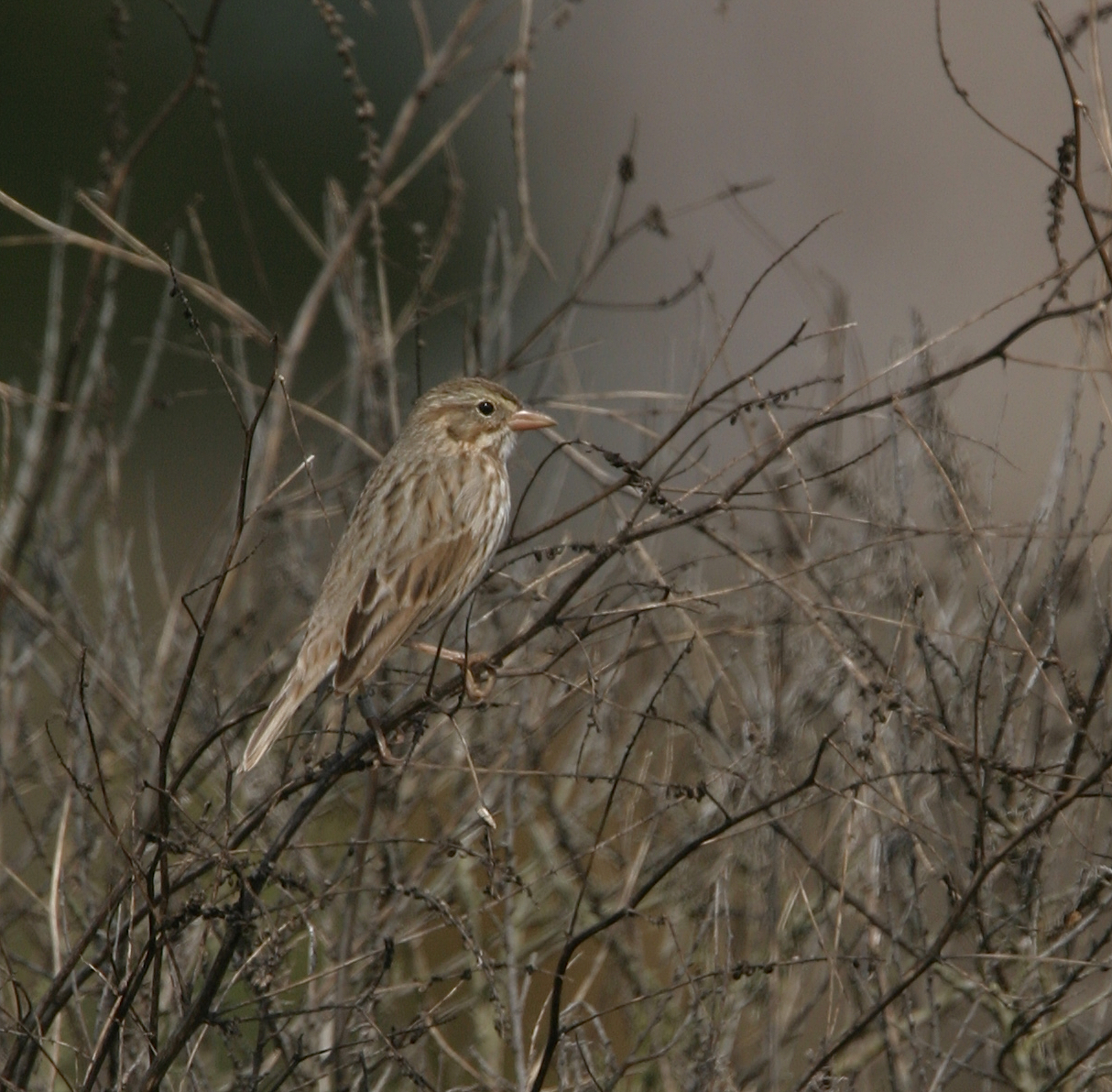
Large-billed Savannah Sparrow
Passerculus sandwichensis rostratus
Passerculus sandwichensis rostratus
Large-billed Savannah Sparrow
Photo Credit: copyright Greg "Slobirdr" Smith
| Historically present | |
| Between 2000 and | |
| Last 10 years |
Ranges from northeastern Baja California and northwestern Sonora during the breeding season [1;2]. During the nonbreeding season, can be found along the central coastal and southern California south along the shores of Baja California to the Cape district, to the islands of the Gulf of California, the Sonoran coast, and northern Sinaloa. Seen in the U.S. chiefly at the Salton Sea [3;4;both cited in 5].
Can be expected anywhere along the coast of the county though does not breed in California and is only a fall and winter visitor [6].
SSC (wintering)
Restricted to shorelines, coastal salt marsh, and mudflats within its California nonbreeding range. Associated with low coastal strand vegetation where Salicornia, Allenrolfea, Suaede, Atriplex, and Distichlis are dominant plants and can be expected anywhere along the coast of San Diego County [1;2;5;6]. Specialized breeding habitat located mainly in the delta mouth of the Colorado River and adjacent coasts of the Gulf of California in northeastern Baja California. Breeds in salt marshes and alkaline sumps of northeastern Baja California and north-western Sonora. Post-breeding dispersants regularly reach southeastern (Salton Sea) and south-coastal California and northwestern Baja California, generally from July through February [1].
One of 17 subspecies currently recognized [Garret 2008]. Subspecies can be divided into five groups: princeps (Ipswich Sparrow), sandwichensis (“typical†Savannah Sparrows), beldingi (Belding's Sparrows and other dark saltmarsh taxa), rostratus (Large-billed Sparrows), and sanctorum (San Benito Sparrow) [1]. Savanna sparrows of coastal southern California, Baja california, and Sonora (beldingi, sanctorum, and rostratus groups) form a distinct clade, with the rostratus group possibly distinct from the others [7]. Within the Rostratus group: P. s. rostratus and P. s. atratus [1].
Diurnal [5]. Generally migrate at night, although some may continue during the day [1].
Nests mainly in March and April in Sonora, but nest building there has been noted as late as June 20th [2]. Females build nests alone [8;9, cited in 1]. Clutch size range of 2-6 eggs, most commonly 4 [1]. Both sexes incubate for about 12 days [5]. First chicks hatch 14-16 days after first egg is laid [1]. Nestlings are altricial and leave 14 days after hatching [5].
Feeds on insects, spiders, snails, and seeds during the winter and migration. Can handle Uca crabs and husk Salicornia seeds. Forages on the ground, sometimes scratches [1;5].
Some are resident but others migrate (now rarely) north or northwest to California or south along both coasts of Baja California. Young depart 11-12 days after hatching (sometimes as early as 8 days) [1].
Decline in population from altered hydrology from changes of breeding habitat in Colorado River Delta [2,6]. Urban development and modification of wintering habitats in California, such as the daily raking of beaches, may also attribute to the decline due to the prevention of kelp and associated food resources for the sparrows to accumulate [2].
[1] Wheelwright, N. T. and J. D. Rising. 2008. Savannah Sparrow (Passerculus sandwichensis), version 2.0. In The Birds of North America (P. G. Rodewald, editor). Cornell Lab of Ornithology, Ithaca, New York, USA. Available: https://birdsna.org/Species-Account/bna/species/savspa/introduction. Accessed: November 06, 2017.
[2] Garrett, K. L. 2008. Part II: Species Accounts, 388-392. Shuford, W. D. and T. Gardali., editors. California Bird Species of Special Concern: A Ranked Assessment of Species, Subspecies, and Distinct Populations of Birds of Immediate Conservation Concern in Californi, Studies of Western Birds No. 1. Western Field Ornithologists, Camarillo, California, and California Department of Fish and Game, Sacramento.
[3] American Ornithologists' Union (AOU). 1957. The A.O.U. Check-list of North American Birds, 5th edition. Port City Press, Inc., Baltimore, MD.
[4] National Geographic Society (NGS). 1983. Field guide to the birds of North America. National Geographic Society, Washington, DC.
[5] NatureServe. 2017. NatureServe Explorer: An online encyclopedia of life [web application]. Version 7.1.NatureServe, Arlington, Virginia. Available: http://explorer.natureserve.org. Accessed: November 16, 2017.
[6] Unitt, P. 2004. San Diego County Bird Atlas. San Diego, CA. San Diego Natural History Museum.Â
[7] Zink, R. M., J. D. Rising, S. Mockford, A. G. Horn, J. M. Wright, M. Leonard, and M. C. Westberg. 2005. Mitochondrial DNA Variation, Species Limits, and Rapid Evolution of Plumage Coloration and Size in the Savannah Sparrow. The Condor 107(1): 21-28.
[8] Welsh, Daniel A. 1975. Savannah Sparrow Breeding and Territoriality on a Nova Scotia Dune Beach. The Auk 92(2): 235-251.
[9] Bédard, J., and M. Meunier. 1983. Parental Care in the Savannah Sparrow. Canadian Journal of Zoology 61(2): 2836-2843.